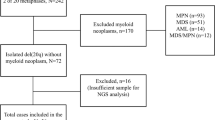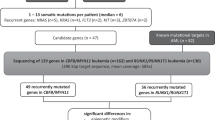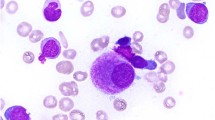Abstract
Overexpression of the ecotropic virus integration-1 (EVI1) gene (EVI1+), localized at chromosome 3q26, is associated with adverse outcome in adult acute myeloid leukemia (AML). In pediatric AML, 3q26 abnormalities are rare, and the role of EVI1 is unknown. We studied 228 pediatric AML samples for EVI1+ using gene expression profiling and RQ-PCR. EVI1+ was found in 20/213 (9%) of children with de novo AML, and in 4/8 with secondary AML. It was predominantly found in MLL-rearranged AML (13/47), monosomy 7 (2/3), or FAB M6/7 (6/10), and mutually exclusive with core-binding factor AML, t(15;17), and NPM1 mutations. Fluorescent in situ hybridization (FISH) was performed to detect cryptic 3q26 abnormalities. However, none of the EVI1+ patients harbored structural 3q26 alterations. Although significant differences in 4 years pEFS for EVI1+ and EVI1− pediatric AML were observed (28%±11 vs 44%±4, P=0.04), multivariate analysis did not identify EVI1+ as an independent prognostic factor. We conclude that EVI1+ can be found in ∼10% of pediatric AML. Although EVI1+ was not an independent prognostic factor, it was predominantly found in subtypes of pediatric AML that are related with an intermediate to unfavorable prognosis. Further research should explain the role of EVI1+ in disease biology in these cases. Remarkably, no 3q26 abnormalities were identified in EVI1+ pediatric AML.
This is a preview of subscription content, access via your institution
Access options
Subscribe to this journal
Receive 12 print issues and online access
$259.00 per year
only $21.58 per issue
Buy this article
- Purchase on Springer Link
- Instant access to full article PDF
Prices may be subject to local taxes which are calculated during checkout



Similar content being viewed by others
References
Wieser R . The oncogene and developmental regulator EVI1: expression, biochemical properties, and biological functions. Gene 2007; 396: 346–357.
Morishita K, Parganas E, William CL, Whittaker MH, Drabkin H, Oval J et al. Activation of EVI1 gene expression in human acute myelogenous leukemias by translocations spanning 300-400 kilobases on chromosome band 3q26. Proc Natl Acad Sci USA 1992; 89: 3937–3941.
Matsugi T, Morishita K, Ihle JN . Identification, nuclear localization, and DNA-binding activity of the zinc finger protein encoded by the Evi-1 myeloid transforming gene. Mol Cell Biol 1990; 10: 1259–1264.
Hoyt PR, Bartholomew C, Davis AJ, Yutzey K, Gamer LW, Potter SS et al. The Evi1 proto-oncogene is required at midgestation for neural, heart, and paraxial mesenchyme development. Mech Dev 1997; 65: 55–70.
Morishita K, Parker DS, Mucenski ML, Jenkins NA, Copeland NG, Ihle JN . Retroviral activation of a novel gene encoding a zinc finger protein in IL-3-dependent myeloid leukemia cell lines. Cell 1988; 54: 831–840.
Nucifora G, Laricchia-Robbio L, Senyuk V . EVI1 and hematopoietic disorders: history and perspectives. Gene 2006; 368: 1–11.
Spensberger D, Delwel R . A novel interaction between the proto-oncogene Evi1 and histone methyltransferases, SUV39H1 and G9a. FEBS Lett 2008; 582: 2761–2767.
Cattaneo F, Nucifora G . EVI1 recruits the histone methyltransferase SUV39H1 for transcription repression. J Cell Biochem 2008; 105: 344–352.
Aytekin M, Vinatzer U, Musteanu M, Raynaud S, Wieser R . Regulation of the expression of the oncogene EVI1 through the use of alternative mRNA 5′-ends. Gene 2005; 356: 160–168.
Fears S, Mathieu C, Zeleznik-Le N, Huang S, Rowley JD, Nucifora G . Intergenic splicing of MDS1 and EVI1 occurs in normal tissues as well as in myeloid leukemia and produces a new member of the PR domain family. Proc Natl Acad Sci USA 1996; 93: 1642–1647.
Huang S, Shao G, Liu L . The PR domain of the Rb-binding zinc finger protein RIZ1 is a protein binding interface and is related to the SET domain functioning in chromatin-mediated gene expression. J Biol Chem 1998; 273: 15933–15939.
Barjesteh van Waalwijk van Doorn-Khosrovani S, Erpelinck C, van Putten WL, Valk PJ, van der Poel-van de Luytgaarde S, Hack R et al. High EVI1 expression predicts poor survival in acute myeloid leukemia: a study of 319 de novo AML patients. Blood 2003; 101: 837–845.
Lugthart S, van Drunen E, van Norden Y, van Hoven A, Erpelinck CA, Valk PJ et al. High EVI1 levels predict adverse outcome in acute myeloid leukemia: prevalence of EVI1 overexpression and chromosome 3q26 abnormalities underestimated. Blood 2008; 111: 4329–4337.
Raimondi SC, Chang MN, Ravindranath Y, Behm FG, Gresik MV, Steuber CP et al. Chromosomal abnormalities in 478 children with acute myeloid leukemia: clinical characteristics and treatment outcome in a cooperative pediatric oncology group study-POG 8821. Blood 1999; 94: 3707–3716.
Vardiman JW, Harris NL, Brunning RD . The World Health Organization (WHO) classification of the myeloid neoplasms. Blood 2002; 100: 2292–2302.
Kardos G, Zwaan CM, Kaspers GJ, de-Graaf SS, de Bont ES, Postma A et al. Treatment strategy and results in children treated on three Dutch Childhood Oncology Group acute myeloid leukemia trials. Leukemia 2005; 19: 2063–2071.
Gibson BE, Wheatley K, Hann IM, Stevens RF, Webb D, Hills RK et al. Treatment strategy and long-term results in paediatric patients treated in consecutive UK AML trials. Leukemia 2005; 19: 2130–2138.
Creutzig U, Zimmermann M, Ritter J, Reinhardt D, Hermann J, Henze G et al. Treatment strategies and long-term results in paediatric patients treated in four consecutive AML-BFM trials. Leukemia 2005; 19: 2030–2042.
Den Boer ML, Harms DO, Pieters R, Kazemier KM, Gobel U, Korholz D et al. Patient stratification based on prednisolone-vincristine-asparaginase resistance profiles in children with acute lymphoblastic leukemia. J Clin Oncol 2003; 21: 3262–3268.
Van Vlierberghe P, van Grotel M, Beverloo HB, Lee C, Helgason T, Buijs-Gladdines J et al. The cryptic chromosomal deletion del(11)(p12p13) as a new activation mechanism of LMO2 in pediatric T-cell acute lymphoblastic leukemia. Blood 2006; 108: 3520–3529.
Balgobind BV, Van Vlierberghe P, van den Ouweland AM, Beverloo HB, Terlouw-Kromosoeto JN, van Wering ER et al. Leukemia-associated NF1 inactivation in patients with pediatric T-ALL and AML lacking evidence for neurofibromatosis. Blood 2008; 111: 4322–4328.
Yamamoto Y, Kiyoi H, Nakano Y, Suzuki R, Kodera Y, Miyawaki S et al. Activating mutation of D835 within the activation loop of FLT3 in human hematologic malignancies. Blood 2001; 97: 2434–2439.
Kiyoi H, Naoe T, Yokota S, Nakao M, Minami S, Kuriyama K et al. Internal tandem duplication of FLT3 associated with leukocytosis in acute promyelocytic leukemia. Leukemia Study Group of the Ministry of Health and Welfare (Kohseisho). Leukemia 1997; 11: 1447–1452.
Barjesteh van Waalwijk van Doorn-Khosrovani S, Erpelinck C, Meijer J, van Oosterhoud S, van Putten WL, Valk PJ et al. Biallelic mutations in the CEBPA gene and low CEBPA expression levels as prognostic markers in intermediate-risk AML. Hematol J 2003; 4: 31–40.
Hollink IH, Zwaan CM, Zimmermann M, Arentsen-Peters TC, Pieters R, Cloos J et al. Favorable prognostic impact of NPM1 gene mutations in childhood acute myeloid leukemia, with emphasis on cytogenetically normal AML. Leukemia 2009; 23: 262–270.
Balgobind BV, Hollink IHIM, Reinhardt D, van Wering ER, de Graaf SSN, Baruchel A et al. Low frequency of MLL-PTD detected in pediatric acute myeloid leukemia using MLPA screening. ASH Annual Meet Abstr 2008; 112: 1512.
Irizarry RA, Gautier L, Bolstad BM, Miller C, Astrand M, Cope LM et al. Affy: methods for affymetrix oligonucleotide arrays. Part of Bioconducter, http://www.bioconducter.org.
Huber W, von Heydebreck A, Sultmann H, Poustka A, Vingron M . Variance stabilization applied to microarray data calibration and to the quantification of differential expression. Bioinformatics (Oxford, England) 2002; 18 (Suppl 1): S96–S104.
Team RDC. R: A Language and Environment for Statistical Computing. R Foundation for Statistical Computing: Vienna, Austria, 2007.
Smyth G . Linear models and empirical Bayes methods for assessing differential expression in microarray experiments. Stat Appl Genet Mol Biol 2004; 3: 1.
Benjamini Y, Hochberg Y . Controlling the false discovery rate: a practical and powerful approach to multiple testing. J Royal Stat Soc B Met 1995; 57: 289–300.
Meijerink J, Mandigers C, van de Locht L, Tonnissen E, Goodsaid F, Raemaekers J . A novel method to compensate for different amplification efficiencies between patient DNA samples in quantitative real-time PCR. J Mol Diagn 2001; 3: 55–61.
Lu Q, Wright DD, Kamps MP . Fusion with E2A converts the Pbx1 homeodomain protein into a constitutive transcriptional activator in human leukemias carrying the t(1;19) translocation. Mol Cell Biol 1994; 14: 3938–3948.
Kuo YH, Zaidi SK, Gornostaeva S, Komori T, Stein GS, Castilla LH . Runx2 induces acute myeloid leukemia in cooperation with Cbfbeta-SMMHC in mice. Blood 2009; 113: 3323–3332.
Laricchia-Robbio L, Nucifora G . Significant increase of self-renewal in hematopoietic cells after forced expression of EVI1. Blood Cells Mol Dis 2008; 40: 141–147.
Kilbey A, Stephens V, Bartholomew C . Loss of cell cycle control by deregulation of cyclin-dependent kinase 2 kinase activity in Evi-1 transformed fibroblasts. Cell Growth Differ 1999; 10: 601–610.
Hasle H, Alonzo TA, Auvrignon A, Behar C, Chang M, Creutzig U et al. Monosomy 7 and deletion 7q in children and adolescents with acute myeloid leukemia: an international retrospective study. Blood 2007; 109: 4641–4647.
Barnard DR, Alonzo TA, Gerbing RB, Lange B, Woods WG . Comparison of childhood myelodysplastic syndrome, AML FAB M6 or M7, CCG 2891: report from the Children's Oncology Group. Pediatr Blood Cancer 2007; 49: 17–22.
Gilliland DG, Griffin JD . The roles of FLT3 in hematopoiesis and leukemia. Blood 2002; 100: 1532–1542.
Goemans BF, Zwaan CM, Miller M, Zimmermann M, Harlow A, Meshinchi S et al. Mutations in KIT and RAS are frequent events in pediatric core-binding factor acute myeloid leukemia. Leukemia 2005; 19: 1536–1542.
Chen W, Kumar AR, Hudson WA, Li Q, Wu B, Staggs RA et al. Malignant transformation initiated by Mll-AF9: gene dosage and critical target cells. Cancer Cell 2008; 13: 432–440.
Tonnies H, Huber S, Kuhl JS, Gerlach A, Ebell W, Neitzel H . Clonal chromosomal aberrations in bone marrow cells of Fanconi anemia patients: gains of the chromosomal segment 3q26q29 as an adverse risk factor. Blood 2003; 101: 3872–3874.
Balgobind BV, Raimondi SC, Harbott J, Zimmermann M, Alonzo TA, Auvrignon A et al. Novel prognostic subgroups in childhood 11q23/MLL-rearranged acute myeloid leukemia: results of an international retrospective study. Blood 2009; 114: 2489–2496.
Laricchia-Robbio L, Fazzina R, Li D, Rinaldi CR, Sinha KK, Chakraborty S et al. Point mutations in two EVI1 Zn fingers abolish EVI1-GATA1 interaction and allow erythroid differentiation of murine bone marrow cells. Mol Cell Biol 2006; 26: 7658–7666.
Kreider BL, Orkin SH, Ihle JN . Loss of erythropoietin responsiveness in erythroid progenitors due to expression of the Evi-1 myeloid-transforming gene. Proc Natl Acad Sci USA 1993; 90: 6454–6458.
Shimizu S, Nagasawa T, Katoh O, Komatsu N, Yokota J, Morishita K . EVI1 is expressed in megakaryocyte cell lineage and enforced expression of EVI1 in UT-7/GM cells induces megakaryocyte differentiation. Biochem Biophys Res Commun 2002; 292: 609–616.
Louz D, van den Broek M, Verbakel S, Vankan Y, van Lom K, Joosten M et al. Erythroid defects and increased retrovirally-induced tumor formation in Evi1 transgenic mice. Leukemia 2000; 14: 1876–1884.
Valk PJ, Verhaak RG, Beijen MA, Erpelinck CA, Barjesteh van Waalwijk van Doorn-Khosrovani S, Boer JM et al. Prognostically useful gene-expression profiles in acute myeloid leukemia. N Engl J Med 2004; 350: 1617–1628.
Lugthart S, Figueroa ME, Valk PJM, Li Y, Erpelinck-Verschueren C, Greally J et al. Two different EVI1 expressing poor-risk AML subgroups with Distinct epigenetic signatures uncovered by genome wide DNA methylation profiling. ASH Annual Meet Abstr 2008; 112: 757.
Shimabe M, Goyama S, Watanabe-Okochi N, Yoshimi A, Ichikawa M, Imai Y et al. Pbx1 is a downstream target of Evi-1 in hematopoietic stem/progenitors and leukemic cells. Oncogene 2009; 28: 4364–4374.
Acknowledgements
This work was funded by the NWO ‘Netherlands Organization for Scientific Research’ (BVB), KOCR ‘Kinder-Oncologisch Centrum Rotterdam’ (BVB and IHH) and EHA (SL).
Author information
Authors and Affiliations
Corresponding author
Ethics declarations
Competing interests
The authors declare no conflict of interest.
Additional information
Author contribution
BVB designed and performed research and wrote the paper. SL and RD designed research. IHH designed and performed research. HBB performed FISH analysis. EW, SSNG, GJK, DR, UC, JS, and JT made this research possible by collecting patient samples and characteristics in their own study groups and providing additional information. MMH-E, CMZ, and RP designed and supervised research and wrote the paper.
Supplementary Information accompanies the paper on the Leukemia website
Rights and permissions
About this article
Cite this article
Balgobind, B., Lugthart, S., Hollink, I. et al. EVI1 overexpression in distinct subtypes of pediatric acute myeloid leukemia. Leukemia 24, 942–949 (2010). https://doi.org/10.1038/leu.2010.47
Received:
Revised:
Accepted:
Published:
Issue Date:
DOI: https://doi.org/10.1038/leu.2010.47
Keywords
This article is cited by
-
EVI1 expression in early-stage breast cancer patients treated with neoadjuvant chemotherapy
BMC Cancer (2022)
-
Myeloid leukemia with high EVI1 expression is sensitive to 5-aza-2′-deoxycytidine by targeting miR-9
Clinical and Translational Oncology (2020)
-
A critical role of epigenetic inactivation of miR-9 in EVI1high pediatric AML
Molecular Cancer (2019)
-
High expression of EVI1 and MEL1 is a compelling poor prognostic marker of pediatric AML
Leukemia (2015)
-
−7/7q− syndrome in myeloid-lineage hematopoietic malignancies: attempts to understand this complex disease entity
Oncogene (2015)



